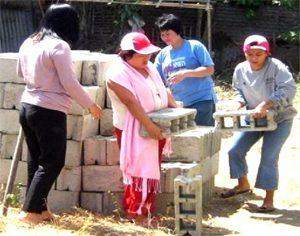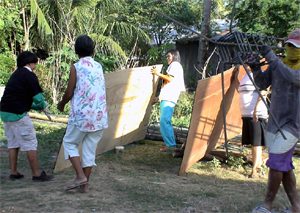
 The tenth in the Seeds of Change series: 20 strategies for systemic change described by members of the Vincentian Family’s Commission for Promoting Systemic Change. The Rev. Fr. Norberto L. Carcellar, C. M. writes:
The tenth in the Seeds of Change series: 20 strategies for systemic change described by members of the Vincentian Family’s Commission for Promoting Systemic Change. The Rev. Fr. Norberto L. Carcellar, C. M. writes:
 Systemic Change Strategy 11 : Involve the poor themselves, including the young and women, at all stages: identification of needs, planning, implementation, evaluation and revision. Right: planning for an improved community
Systemic Change Strategy 11 : Involve the poor themselves, including the young and women, at all stages: identification of needs, planning, implementation, evaluation and revision. Right: planning for an improved community
The Homeless Peoples Federation Philippines, Inc. (HPFPI) shows this strategy at work. As dwellers in the slums of Iloilo City and Mandaue City became involved and harnassed their capacities, they improved their own communities. Indeed, without the participation of the poor, no systemic change can be achieved. The poor are the prime stakeholders in any project for change because they are the ones suffering and dealing with the risks of surviving poverty.
The poor are the first source of information, experience, and insight on coping with poverty. And when given the space to identify, analyze and plan, they empower themselves. Involving the poor — especially youth, women, and vulnerable groups — in all aspects of change initiatives is therefore crucial.
HPFPI’s community-led approach involves the following major strategies:
-
 mobilizing slum communities through community consultations and orientations on organizational development, paralegal and para-engineering, the conduct and analysis of community socio-economic survey enumerations, hands-on action research, and issue-based local and international learning exchanges;
mobilizing slum communities through community consultations and orientations on organizational development, paralegal and para-engineering, the conduct and analysis of community socio-economic survey enumerations, hands-on action research, and issue-based local and international learning exchanges; - establishing community savings and finance schemes that not only develop the asset base but more importantly develops community, city, regional and national-level cohesion among the HPFPI member associations;
- undertaking actual land and housing negotiations, acquisition, technical trainings, construction and management;
- engaging and establishing networks / partnerships among slum dwellers, and with local, national public and private technical, financial , legal institutions and academia;
- advocating for city wide, community-led secure land tenure initiatives.
Thus prepared, the nine (9) slum dweller communities in both cities have capacitated themselves, built the confidence to recognize and mitigate the risks, and actually construct and manage their own slum upgrading.
 The personal and communal involvement of the poor in all stages of the change intervention requires a corresponding involvement in the process by the change agents. For real change to ensue, it is not sufficient for change agents to challenge the poor in taking on the cudgels of their empowerment.
The personal and communal involvement of the poor in all stages of the change intervention requires a corresponding involvement in the process by the change agents. For real change to ensue, it is not sufficient for change agents to challenge the poor in taking on the cudgels of their empowerment.
Change agents must be willing to and actually take on the same risks with the poor. This demands a willingness on the part of the change agents to roll up their sleeves, immerse, swim and learn with the poor – away from their accustomed comfort zones. Such 360 degree interplay reflects the paradigm shift of development interventions from a mere product delivery mechanism into a dynamic process of consistently involving the poor and in change agents’ taking and sharing of the risks involved.
Tags: Featured

This is terrific. Every community has assets — even the poorest of communities. Partnering with them is a real instance of of Christmas being “friends,” as Jesus called us. Take a look at a tool for “mapping your assets” at http://www.sesp.northwestern.edu/abcd/tools/abcdci/ You can us it, or tailor it to your own situation.